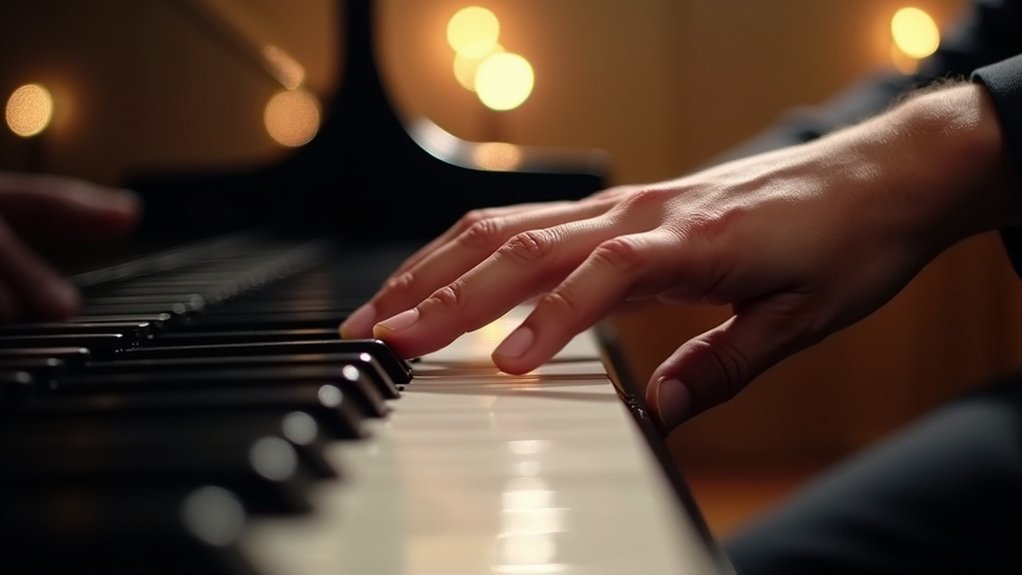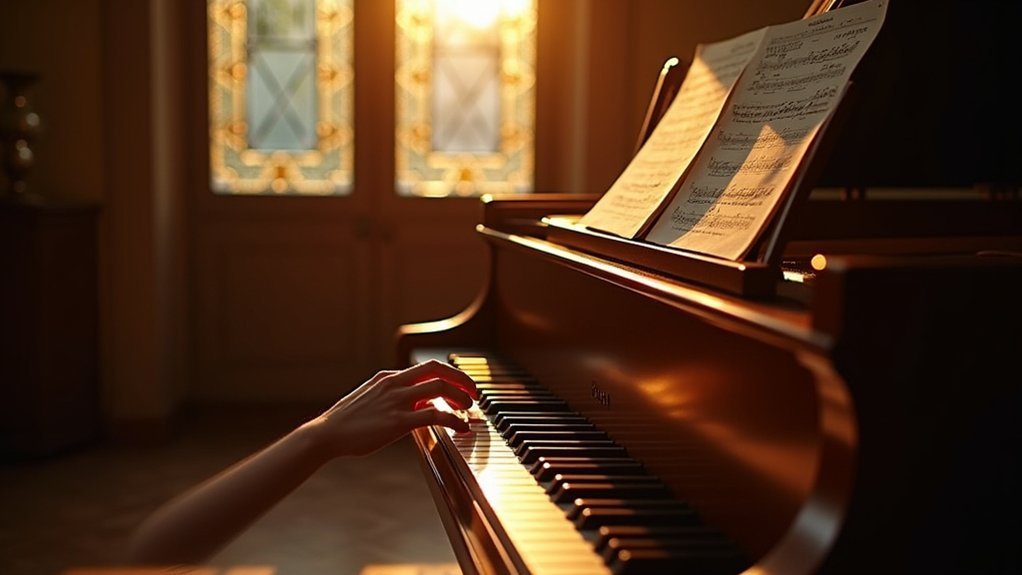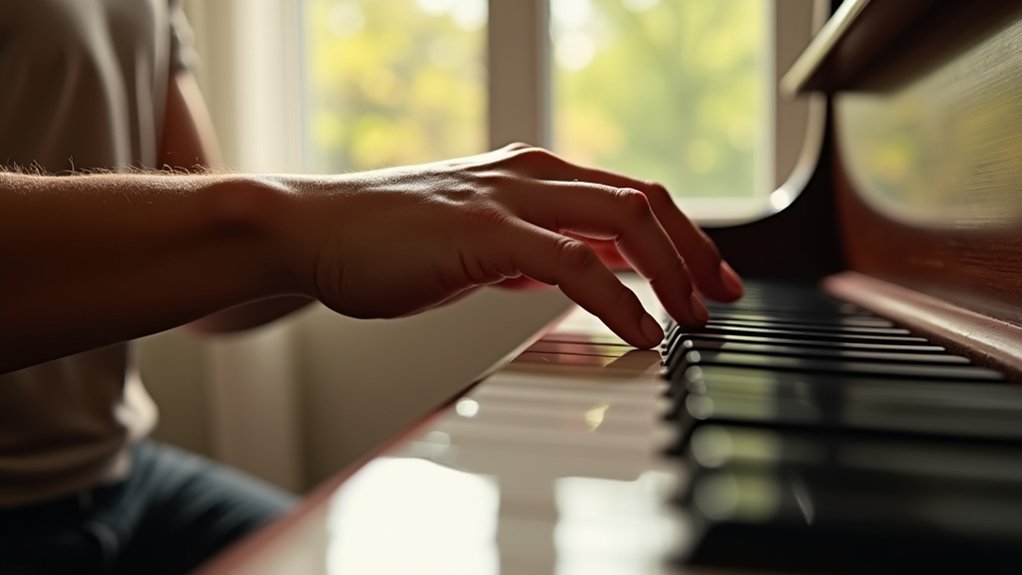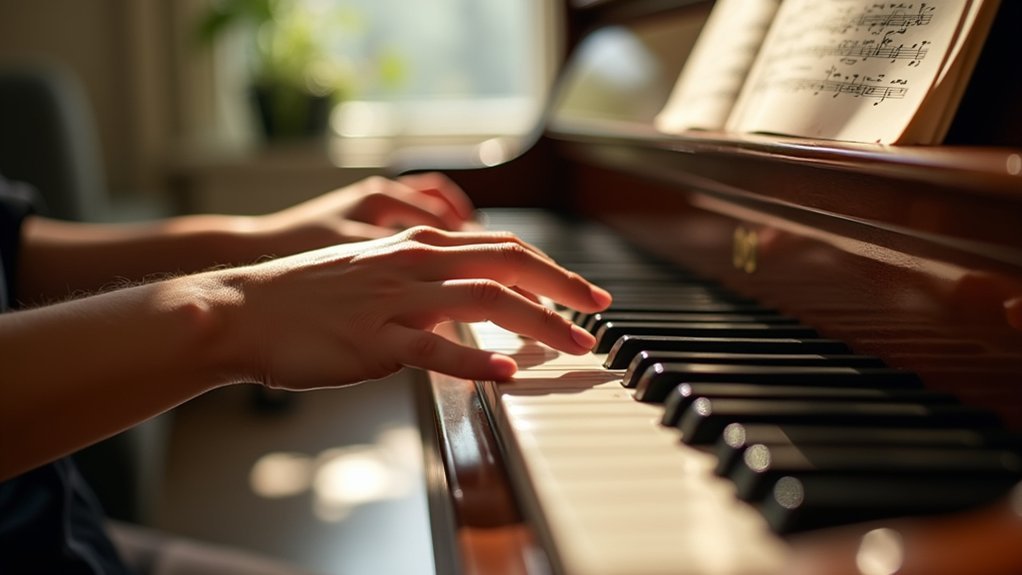Playing piano with one hand can reveal unique artistic expressions while overcoming physical limitations. You’ll develop extraordinary dexterity, access specialized repertoire created by masters like Liszt and Ravel, and discover creative pedal techniques that compensate for your single-hand approach. Whether you’re adapting to temporary injury, permanent disability, or seeking a new challenge, one-handed piano playing offers remarkable benefits. Specialized techniques and adaptive technologies make this musical journey both accessible and rewarding for determined pianists.
Why Play Piano With One Hand Successfully?

Although many assume piano playing requires two hands, mastering one-handed techniques opens up remarkable musical possibilities.
Whether you’re temporarily injured or have a permanent limitation, one-handed piano lessons can help you develop adaptive techniques that foster creative expression.
Playing with one hand encourages exploration of monophonic and contrapuntal styles, allowing you to discover diverse musical textures you might otherwise overlook.
You’ll enhance fine motor skills and coordination while improving cognitive functions related to music processing.
Resources like the Rainbow of Sound series provide repertoire specifically designed for one-handed pianists, making your musical journey accessible and enjoyable.
Through this focused practice, you’ll develop resilience and determination that resonates beyond the keyboard, inspiring both yourself and listeners through your musical achievements.
Essential Benefits of Single-Hand Piano Practice
These specialized techniques we’ve discussed translate into powerful advantages for pianists. When you engage in single-hand practice, you’ll develop remarkable fine motor skills and coordination that enable you to master complex melodies with just one hand.
Playing the piano this way enhances your cognitive abilities as you can focus entirely on expression and interpretation without dividing your attention between both hands. You’ll likely experience greater confidence as you explore repertoire specifically suited to your abilities and progress at your own pace.
Single-hand practice encourages creative approaches to musicality through pedal work and dynamic control.
Beyond technical benefits, research confirms that playing the piano—even with one hand—improves memory and emotional well-being, offering a therapeutic outlet particularly valuable for those with physical limitations.
Historical Repertoire Specifically Composed for One Hand

Remarkable musical innovation emerged when celebrated composers began creating works specifically for single-hand performance.
The ingenuity of crafting single-hand compositions revealed music’s extraordinary capacity to transcend physical boundaries.
You’ll find Franz Liszt composed pieces for left hand alone, crafting challenging works that didn’t compromise on musical depth despite physical constraints.
The repertoire expanded considerably after World War I when Maurice Ravel wrote his famous “Concerto for the Left Hand” for Paul Wittgenstein, a pianist who lost his right arm in battle.
These compositions aren’t simplified versions but rather sophisticated works employing counterpoint and complex rhythms to create full, rich sounds.
When exploring this historical repertoire, you’ll discover how composers ingeniously balanced melody and harmony to overcome the limitations of one-handed playing, proving that artistic expression needn’t be limited by physical constraints.
Adapting Standard Piano Techniques for Limited Mobility
You’ll find that modifying your fingering approach opens up possibilities for playing pieces originally written for two hands, often requiring creative positioning to reach extended passages.
When playing with one hand, you can compensate for your limited reach by strategically using the sustain and sostenuto pedals to hold bass notes while your hand moves to higher registers.
These pedal techniques not only enhance the fullness of your sound but also create the impression of two-handed playing through careful timing of note releases and pedal changes.
Fingering Modifications Strategies
While traditional piano techniques assume the use of both hands, adapting fingering for one-handed playing requires strategic modifications that maximize efficiency and expression.
When you play with one hand, prioritize re-fingering passages to utilize all available fingers effectively, focusing on comfortable shifts that minimize strain.
Incorporate finger substitutions strategically, especially using your thumb to cover notes typically assigned to other fingers. This approach maintains melodic integrity while allowing smoother navigation across the keyboard.
Simplify chords by eliminating doubled notes while preserving essential harmonies.
The damper pedal becomes your ally, creating sustain that compensates for your hand’s physical limitations.
Dedicate practice time to finger strength exercises specifically designed for one-handed playing—these will dramatically improve your dexterity, control, and expressive capabilities over time.
Pedal Compensation Techniques
Beyond fingering adaptations, mastering pedal techniques offers one-handed pianists a powerful arsenal for creating fullness and dimension in their playing.
When you engage the damper and sostenuto pedals strategically, you can sustain notes while your hand moves to new positions, creating the illusion of two hands playing simultaneously.
Position your foot thoughtfully to reduce strain on your performing hand while maintaining clean shifts between passages.
Try using pedal engagement during key changes or dynamic shifts to produce a fuller sound that mimics two-handed performance.
Experiment with different pedal combinations to discover unique tonal qualities that enrich your musical expression.
With regular practice, these pedal compensation techniques will improve your coordination and timing, allowing you to execute complex pieces with confidence despite one-handed playing limitations.
Building Core Strength and Dexterity in Your Playing Hand

The foundation of successful one-handed piano playing rests on developing exceptional strength and dexterity in your playing hand. When you play piano with one hand, your fingers must handle both melodic and harmonic elements simultaneously, demanding greater control than typical two-hands playing.
Focus on daily finger exercises, particularly scales and arpeggios, to enhance finger independence. Incorporate regular stretching routines to reduce tension and improve flexibility across the keyboard.
Consider adding weighted finger exercises using resistance bands to build endurance and muscle tone in your playing hand.
Practice with a metronome at various speeds to reinforce rhythmic precision while developing coordination. This deliberate training regimen will transform your hand’s capabilities, allowing you to execute complex passages with the finesse and power that one-handed repertoire demands.
Famous Pianists Who Mastered One-Handed Performance
Inspiration abounds in the remarkable stories of pianists who transformed physical limitations into artistic triumphs. Paul Wittgenstein, after losing his right arm in WWI, commissioned iconic one-handed compositions from composers like Ravel and Britten, revolutionizing piano one hand repertoire.
| Pianist | Contribution to One-Handed Playing |
|---|---|
| Paul Wittgenstein | Commissioned left-hand works from major composers |
| Horace Parlan | Developed unique jazz style with limited right hand |
| Mark W. McKenzie | Created adaptations for one-handed performance |
| Franz Liszt | Composed early one-handed piano pieces |
| Leon Fleisher | Continued performing despite losing right hand function |
These musicians prove that playing piano with a single hand isn’t merely compensation but can become a distinctive artistic expression. Their legacies demonstrate that determination and creativity can overcome physical limitations, inspiring countless musicians facing similar challenges.
Pedal Techniques to Enhance One-Handed Expression
To maintain melodic flow with one hand, you’ll need to master the sustain pedal’s art of connecting notes that your fingers can’t physically hold.
Cross-pedaling—changing the pedal partway through sustained notes—adds dimension to your playing by creating overlapping sounds that compensate for your limited reach.
The una corda (soft) pedal isn’t just for volume control; it creates tonal nuance that can distinguish melody from accompaniment when you’re managing both with a single hand.
Sustain for Melodic Flow
When playing piano with one hand, mastering pedal techniques becomes essential for creating the illusion of multiple voices and sustained harmonies. The damper pedal serves as your ally, allowing notes to continue resonating while your fingers move to new positions. This sustain creates a connected melodic flow that transcends the limitations of playing with a single hand.
Try varying your pedal techniques—half-pedaling can provide subtle control over note decay, maintaining clarity while adding richness to your sound. The sostenuto pedal offers another dimension, selectively sustaining specific notes while keeping others crisp and articulate.
As you practice, focus on coordinating finger movements with precise pedal timing. This synchronization compensates for your free hand’s absence, producing fuller textures and more expressive performances. The pedal becomes your musical partner, expanding what’s possible with just five fingers.
Cross-Pedaling Adds Dimension
Cross-pedaling techniques elevate one-handed piano playing from mere melody to multidimensional artistry. By strategically using the sustain pedal, you’ll connect notes seamlessly while creating depth in your performance that might otherwise be impossible with just one hand.
When mastering cross-pedaling for one-handed melodies, focus on:
- Alternating between damper and sostenuto pedals to maintain harmonic backgrounds
- Sustaining bass notes while playing treble melodies to create fuller textures
- Using half-pedaling to achieve subtle layering effects in your passages
- Practicing deliberate pedal releases to maintain clarity between phrase shifts
This technique builds your understanding of harmonic support and phrasing, vital elements for emotional expression.
You’ll engage audiences more effectively as cross-pedaling transforms simple lines into rich musical landscapes, making your one-handed performances sound remarkably complete.
Una Corda Creates Nuance
While sustain pedaling adds resonance, the una corda pedal offers an entirely different dimension to your one-handed piano playing through its subtle tonal transformations. This “soft pedal” allows you to achieve greater expressive control by shifting the hammers to strike fewer strings, creating a more delicate sound that compensates for your single-hand limitations.
| Una Corda Effect | Playing Application |
|---|---|
| Softens tone | Lyrical passages |
| Mutes volume | Emotional depth |
| Alters timbre | Genre adaptation |
| Enhances color | Phrase emphasis |
Overcoming Common Challenges in One-Hand Piano Playing
Despite the limitations that one-handed pianists face, numerous strategies exist to transform these challenges into opportunities for creative expression. When you’re learning to play with one hand, you’ll need to adjust your approach to maintain musicality and technical proficiency.
- Optimize your posture – Position your bench and body to maximize reach across the keyboard and access to pedals.
- Adapt existing repertoire – If you’re right-handed, transpose left-hand pieces to suit your needs.
- Explore varied textures – Practice with monophonic and contrapuntal music to develop versatility.
- Join supportive communities – Connect with fellow one-handed pianists to share techniques and stay motivated.
Remember that limitations often spark creativity. By embracing these adaptations, you’ll discover new ways to express yourself musically that mightn’t have emerged otherwise.
Modified Instruments and Adaptive Technologies
Modified instruments like specialized one-handed keyboards can transform your musical experience by offering tailored layouts that maximize what you can play with a single hand.
You’ll find digital assistance tools that compensate for missing notes, with software that can mirror your playing or automatically add bass accompaniment to your melody.
These adaptive technologies continue to evolve, with options ranging from smartphone apps that function as secondary controllers to MIDI systems that can be programmed to fill in musical elements you can’t physically reach.
Specialized One-Handed Keyboards
Innovation has revolutionized accessibility in piano playing through the development of specialized one-handed keyboards. These instruments are specifically designed to address your physical limitations while maintaining musical expression.
- Customizable layouts give you easier access to keys and controls, allowing comfortable positioning whether you’re left or right-handed.
- Touch-sensitive technology responds to your unique playing style, creating personalized sound profiles.
- Adjustable heights and larger keys accommodate individual ergonomic needs, reducing strain during extended practice.
- Digital interfaces connect with adaptive technologies like foot pedals and switches, enabling you to control multiple functions simultaneously.
These specialized keyboards aren’t just modified instruments—they’re thoughtfully engineered tools that empower you to create beautiful music regardless of physical constraints.
This proves that artistic expression remains accessible to all musicians.
Digital Assistance Tools
While traditional piano design presents challenges, today’s digital assistance tools offer revolutionary solutions for one-handed pianists.
Adaptive technologies like customizable piano apps and virtual keyboards let you practice at your own pace, with interfaces that adjust to your specific needs.
One-handed pianos with modified layouts make playing possible without requiring two hands, while MIDI controllers expand your creative horizons by assigning multiple sounds to single key presses.
You’ll find touchscreens and digital interfaces that respond to your unique playing style.
These tools connect to vast online libraries of sheet music specifically arranged for one-handed play.
You can also join supportive communities where fellow one-handed pianists share experiences and resources, creating a collaborative environment that turns physical limitations into new musical possibilities.
Teaching Strategies for One-Handed Piano Students
Despite common misconceptions, teaching piano to students with the use of only one hand offers rich opportunities for musical development and expression. When you Learn to Play with one hand, specialized approaches can create fulfilling musical experiences.
- Repertoire selection – Choose music specifically composed for one hand that engages students while matching their skill level.
- Technical focus – Develop monophonic melodies to build finger strength and dexterity with single-note lines.
- Texture development – Introduce both contrapuntal and homophonic techniques to create musical depth despite physical limitations.
- Creative ownership – Encourage improvisation and original composition to foster enjoyment and personal expression.
Implementing gradual tempo changes and targeted repetition helps stabilize performance, allowing students to experience the full joy of piano playing regardless of using just one hand.
Arranging Multi-Hand Pieces for Single-Hand Performance
Building on these teaching strategies, many pianists eventually face the challenge of adapting two-hand compositions for one-hand performance. When arranging pieces, identify the primary melodic lines and harmonic elements that define the composition’s character.
Adapting music for single-hand performance requires careful identification of essential melodic and harmonic elements that define the piece’s character.
You’ll need to re-finger sections strategically to accommodate your hand’s physical limitations while preserving musical integrity. Consider dropping doubled notes and adjusting chord voicings to make passages playable without sacrificing expressiveness.
The pedals become your allies in single-hand arrangements—utilize the damper and sostenuto pedals to sustain notes while your hand moves to new positions, creating a fuller sound that mimics two-handed playing.
Explore both monophonic and contrapuntal styles when selecting pieces for arrangement, choosing compositions that best match your technical abilities and expressive goals.
Frequently Asked Questions
Why Is It so Hard to Play Piano With Both Hands?
Your brain must split attention between two independent tasks simultaneously. You’re processing different rhythms, notes, and movements for each hand while coordinating them into one cohesive piece. It’s neurologically challenging.
Is It Possible to Play the Piano With One Hand?
Yes, you can absolutely play piano with one hand! Many composers have written pieces specifically for one-handed performance, and you’ll find dedicated repertoire that allows for beautiful and expressive musical possibilities.
Is It Easier to Play Piano if You Are Ambidextrous?
Yes, if you’re ambidextrous, you’ll likely find piano playing somewhat easier. Your enhanced coordination between brain hemispheres gives you advantages in dexterity, adaptability, and balancing melodic and harmonic elements with either hand.
How Long Does It Take to Learn Piano With Both Hands?
You’ll typically need 6-12 months to develop basic two-handed piano playing skills. With daily 30-60 minute practice sessions, you’ll see steady progress, though mastering complex pieces requires years of dedicated practice.
In Summary
One-handed piano playing isn’t just a limitation—it’s an opportunity to explore new techniques and repertoire. Whether you’re recovering from injury, dealing with permanent mobility issues, or simply strengthening individual hand independence, you’ll find rich musical possibilities waiting. With dedicated practice, appropriate adaptations, and the right mindset, you’ll create beautiful music that challenges perceptions and celebrates what’s possible with just five fingers.





Leave a Reply